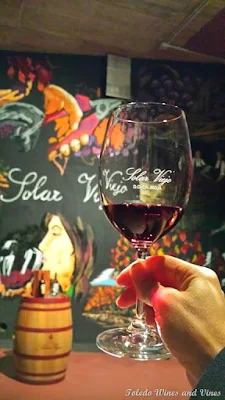Punishing Weather and Welcoming Wine
There are more than 600 wineries in Rioja, producing 400 million bottles of wine annually. Most of the wine is red and Tempranillo is “king of the vineyard” although other grapes are permitted.
The weather remained a threatening mixture of sunshine and shadow, but we soon entered Rioja. Around us was a rolling landscape of orange, light and dark brown, and dull green colors accented with rows of vines. The horizon was fringed with snow-dusted mountains. Luckily, it was very welcoming inside the winery.
The Solar Viejo Tradition
 Bodegas Solar Viejo was founded in 1937 in the medieval town of Laguardia. The name derives from Casas Solariegas, the traditional noblemen’s houses in the town where Solar Viejo wine was first made. Now Solar Viejo is located in the heart of the Alavesa sub-region of Rioja.
Bodegas Solar Viejo was founded in 1937 in the medieval town of Laguardia. The name derives from Casas Solariegas, the traditional noblemen’s houses in the town where Solar Viejo wine was first made. Now Solar Viejo is located in the heart of the Alavesa sub-region of Rioja.Laguardia was established in the 10th Century as a fortress for the kingdom of Navarra. The city has many underground tunnels built for defensive purposes, but which also served as excellent wine cellars.
Today Solar Viejo is a modern winery operation, but maintains close connection with the land and the people. The winery has five hectares of vineyard, but controls 400 hectares. It produces three million bottles annually, which puts it in the mid-size category, at least in Rioja.
Wines of Distinction
There are four categories of wine in Rioja. The Cosecha label has typically been used for wines within 12-24 months of harvest. (However, it now can also be used for wines that do not want to be constrained by the very strict Crianza, Reserva, Gran Reserva rules each year.) Crianza is at least two years old with at least one in oak. Reserva is select wine three years old with one in oak. Grand Reserva is produced during exceptional vintages and aged for at least two years in oak and three in the bottle.
We were able to taste the Solar Viejo wines accompanied by traditional Navarra dishes. As a starter we had white Navarra asparagus followed by Patatas a la Riojana (Rioja style potatoes). Here I must point out an apparent breakdown in translation. Our delicious potato dish was served with a slender green pepper. I asked is this hot? The response was “oh, no.” Well, can you say “caliente!?” I think I heard some laughter from the kitchen.
A highlight of our visit was small lamb chops roast in a brick oven over sarmientos, small bundles of dried cuttings from the vineyard. Pair this with a Vaza Crianza Tempranillo and it is quite heavenly.
Artistry In The Bottle
We were able to compare the 2012 and 2013 Crianza side by side and there was quite a difference. The 2012 harvest was dry in spring and summer and the fruit was rich and ripe. In 2013 it was the opposite, with rain and cool temperatures. This is reflected in the glass. The 2013 has vanilla and cinnamon flavors while the 2012 has heavy tannins.
The Solar Viejo Tempranillo and the Vaza are traditional Rioja wine, Tempranillo rich with vanilla imbued by American oak barrels. Solar Viejo produces a couple of non-traditional wines.
 The 2013 Orube (Basque for Solar) is a blend of 80% Tempranillo, 15% Graciano and 5% Garnacha. It spends 12 months in oak, primarily French, and is a more savory wine with complex intensity.
The 2013 Orube (Basque for Solar) is a blend of 80% Tempranillo, 15% Graciano and 5% Garnacha. It spends 12 months in oak, primarily French, and is a more savory wine with complex intensity. The showstopper for me was the 2011 Orube Vino de Autor. This is the winemakers wine – using 60 to 80-year-old vines from the best vineyards and then selecting only the perfect, flavorful grapes. The winemaker uses malolactic fermentation and the wine is aged in new French oak for 14 months.
“This wine is our own little baby,” said Vanessa Berez of Solar Viejo. We were urged to let the wine open and evolve in the glass. In the tasting room we were able to look out over the stormy Rioja vineyards while sampling Idiazabal cheese. The cheese is “zero kilometer” food coming from a nearby farm.
The Orube Vino de Autor is powerful and complex with notes of black fruit and oak. There is a touch of sweetness and an enveloping finish.
The same could be said for our visit to Rioja and Solar Viejo. Rioja is one of the world’s premier wine regions. While built on centuries of tradition, new styles and creative approaches are emerging to the delight of wine lovers.
As if signaling agreement, a rainbow appeared as we left the winery.







No comments:
Post a Comment